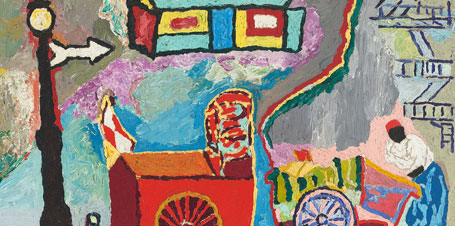
Greene Street, 1946
Oil on canvas
16 x 20 inches
The J. Harwood and Louise B. Cochrane Fund for American Art, 2010.104
As a youngster, I was always doing something with my hands – modeling with the red Tennessee clay, drawing, copying pictures, or strumming my ukulele. As a teenager, I met Lloyd Branson, a local artist in Knoxville who let me work as a porter in exchange for art lessons. He helped send me to art school in Boston, where I fell in love with Monet and Sargent.
I went to New York in 1929 all alone and with very little money. This was the Depression, and I soon discovered that most of these people were people out of work and just doing what I was doing – sitting and figuring out what to do for food and a place to sleep. I felt an immediate connection with New York, this multitude of people of all races – some spending every night of their lives in parks and cafes, surviving on almost nothing. I felt that somehow, someway, this was something I could manage. If only with some stronger force of will I could find the courage to surmount the terror and fear of this immense city and accept everything insofar as possible with calm and determination.
I feel like I never drew a decent thing until I felt the rhythm of New York. The city has a rhythm as distinct as the beating of a human heart. And I’m trying to put it on canvas. I paint people–people – and in their faces I hope to discover that odd, mysterious rhythm. Soon after I arrived, I looked up W.E.B. DuBois in the directory and went to the office. He was very busy, and his secretary came and spoke with me. And I told her that, if Mr. DuBois didn’t mind, I would like to make a drawing of him. And she said, “You can make a drawing, but he won’t stop. Just go and make it.” Which is what I did. I soon began to earn money by painting portraits of wealthy, high-society people, writers, actors, and musicians.
I lived on Greene Street in Lower Manhattan for sixteen years and painted what I saw. Fire escapes, lampposts, hydrants, I made street scenes full of color and remembrances and solitudes – this is one of them. I painted parks, jazz clubs, and my own art studio. These were not snapshots of life as much as they were expressions of how it felt to be in the city. My paintings became a kind of salvation, a way to escape the hardness of day-to-day life. Don’t ever forget that we are aware of the universal misery of our time and world, and we are trying in our various ways to contribute that which is relatively sane.
